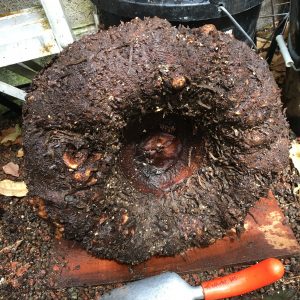
Corina Rieder, Horticulturist
It’s been a long seven years since Maladora the titan arum last bloomed and, boy, was I was taken by surprise this week. My observations of the emerging bud during these last few weeks pointed towards a new leaf – the new shoot was quite slim until recently when it fattened up and revealed a hint of spadix. You might be wondering ‘What has been going on all this time?’ The simple answer is that ‘she’ has just been growing since 2010 (three leaf cycles) to get back the needed strength to flower once more. Titan arums grow from an underground storage organ (a corm) which changes size during each growth period. When more energy is used to sustain a leaf or produce an inflorescence, the corm shrinks, but, when more plant calories are gained through photosynthesis, the corm gains weight, encouraging a bloom.

Repotting Maladora in May 2017 at 27 1/2 lbs
It seems straightforward enough that a titan arum should only grow bigger each time it’s in leaf and will eventually set a flowering bud for the next cycle. Since I began here at UCBG, Maladora has been in leaf twice yet gained roughly two pounds (now 27.5 lb). Maladora, ‘her’ sibling Odoardo, and ten+ seedlings are getting the best care I can provide. Still, growing conditions haven’t been exactly ideal as the Garden’s Tropical House isn’t always like the steamy wilds of Sumatra. The space is difficult to keep heated properly in winter time, so it can be chilly and dim in the T-House. The heaters are cranky, hail has broken glass panes, while the surrounding palm trees now give more than enough shade. Even our local ‘June Gloom’ in summer can slow down the lush growth inside. So you see, I wasn’t quite expecting Maladora to flower this year. Though, of course, this thought is always somewhere in the back of my mind: Expect the Unexpected.
If you miss this opportunity to visit Maladora in bloom, stay in touch. Odoardo has just gone dormant after a very good 17 months of growth. Its been almost ten years since ‘he’ flowered- so keep your fingers crossed.
